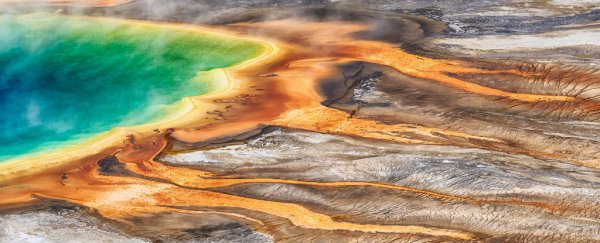For the first time, scientists have started to map what lurks beneath the Yellowstone Supervolcano in Wyoming, so we can finally see the vast subterranean systems that fuel the famous Old Faithful geyser, and other hydrothermal vents at Yellowstone National Park.
These maps will also allow us to better predict if and when a 'super-eruption' could occur in the area - something that hasn't happened in 13,800 years, but when it did, it left behind the largest crater of its kind on the planet.
"This is really kind of a last frontier if you will, in Yellowstone, of being able to look at a large part that's underground that people have not looked at," one of the team Carol Finn, from the US Geological Survey, told the media.
"There's just a lot we don't know, and this survey is really exciting because it's going to be the first view of a large portion of the groundwater system, of the water underground that feeds all of these thermal features."
You might imagine the Yellowstone Supervolcano as like a supersized volcano, rising up out of the ground and puffing whirls of menacing smoke from its gaping mouth, but in reality, it's like a giant volcano that collapsed in on itself to form vast cauldron-like depressions.
These depressions are called caldera, and they form when a volcano spews so much magma during an eruption, its now-empty chamber causes the whole thing to collapse like a massive sinkhole, leaving behind a massive crater.
But it's not like these craters have stopped exploding - the entire Yellowstone Supervolcano is like a vast volcanic field, covering an area of roughly 55 by 72 km (34 by 45 miles), where lava eruptions and swelling steam vents litter the otherworldly landscape.
There have been three super-eruptions over the past couple of million years, with the Huckleberry Ridge eruption 2.1 million years ago; the Mesa Falls eruption 1.3 million years ago; and the Lava Creek eruption roughly 630,000 years ago.
A smaller steam explosion around 13,800 years ago left behind a 5-km-diameter (3.1-mile) crater on the edge of Yellowstone Lake, which is thought to be the largest of its kind in the world.
According to the Yellowstone National Park, 20 visitors have died due to minor explosions from the geothermal vents and hot spring - the most recent in 2000, when a tourist was scalded by boiling waters as hot as 121 degrees Celsius (250 degrees Fahrenheit).
Needless to say, this is not a place that we want to be surprised by. It's time we knew exactly what's lurking below, so we can do a better job at predicting these explosions - large, small, and super.
The new mapping project, which got underway on November 7, is starting with a helicopter electromagnetic and magnetic survey, which can sense even the tiniest voltages sparking underground.
The helicopter is fitted with a giant, hoop-shaped electromagnetic system, which it suspends over the Yellowstone grounds by flying around 60 metres (200 feet) above the surface.
Not only can this equipment detect subterranean electrical activity from above the surface, it also acts like a giant X-ray machine, detecting the shapes and behaviour of things like geysers, hot springs, mud pots, steam vents, and hydrothermal explosion craters to depths of up to 500 metres (1,500 feet).
It will also be able to detect where and how hot water flows beneath the surface.
"Nobody knows anything about the flow paths" of hot water that erupts from Yellowstone's geysers, Finn told the Associated Press. "Does it travel down and back up? Does it travel laterally?"
What we do know, thanks to study carried out last year, is that there's way more magma below Yellowstone than anyone had imagined, with researchers detecting a second reservoir of hot, partly molten rock underneath the more shallow magma chamber we already knew about.
As we reported back in April 2015, this vast reservoir lies some 20-45 kilometres (12-27 miles) beneath the supervolcano, and this new chamber could fill the Grand Canyon up 11.2 times.
And we don't want any of that fuelling a calderic eruption without some kind of warning first, as Sarah Kaplan reports for The Washington Post:
"A calderic eruption, in which that magma came rushing to the surface, would eject 1,000 times more material than the 1980 eruption of Mount St. Helens [the deadliest eruption in US history], and could create a caldera dozens of miles wide.
The last time this happened, 640,000 years ago, Homo sapiens didn't even exist yet. No one is certain what causes such an eruption, or when the Yellowstone supervolcano might erupt again."
The mapping survey is being run by the US Geological Survey, the University of Wyoming, and the Aarhus University in Denmark. It's expected to take four weeks, and it will inform future ground-based surveys around the volcanic hotspot.
We seriously cannot wait to see what they find.
